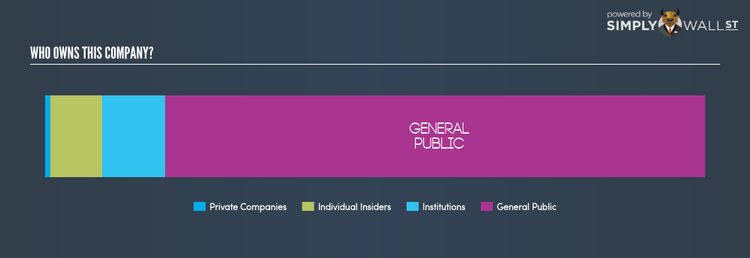Why Amex Exploration Inc’s (CVE:AMX) Ownership Structure Is Important

In this analysis, my focus will be on developing a perspective on Amex Exploration Inc’s (TSXV:AMX) latest ownership structure, a less discussed, but important factor. Ownership structure of a company has been found to affect share performance over time. Differences in ownership structure of companies can have a profound effect on how management’s incentives are aligned with shareholder returns, which is why we’ll take a moment to analyse AMX’s shareholder registry.
See our latest analysis for Amex Exploration
Institutional Ownership
Institutional investors are one of the largest group of market participants and their buy-sell decisions on a company’s stock can significantly impact prices, more so, when there are relatively small amounts of shares available on the market to trade. With an institutional ownership of 9.56%, AMX doesn’t seem too exposed to higher volatility resulting from institutional trading.
Insider Ownership
Another important group of shareholders are company insiders. Insider ownership has to do more with how the company is managed and less to do with the direct impact of the magnitude of shares trading on the market. With 7.88% ownership, AMX insiders is an important ownership type. This level of stake with insiders indicate highly aligned interests of shareholders and company executives. It may be interesting to see what insiders have been doing with their shares lately. Insiders buying shares can be a positive indicator of future performance, but a selling decision can be simply driven by personal financial needs.
General Public Ownership
The general public holds a substantial 81.67% stake in AMX, making it a highly popular stock among retail investors. With this size of ownership, retail investors can collectively play a role in major company policies that affect shareholders returns, including executive remuneration and the appointment of directors. They can also exercise the power to decline an acquisition or merger that may not improve profitability.
Private Company Ownership
Another important group of owners for potential investors in AMX are private companies that hold a stake of 0.89% in AMX. These are companies that are mainly invested due to their strategic interests or are incentivized by reaping capital gains on investments their shareholdings. However, an ownership of this size may be relatively insignificant, meaning that these shareholders may not have the potential to influence AMX’s business strategy. Thus, investors not need worry too much about the consequences of these holdings.
Next Steps:
With a low level of institutional ownership, investors in AMX need not worry about non-fundamental factors such as ownership structure causing large impact on stock prices. However, ownership structure should not be the only focus of your research when constructing an investment thesis around AMX. Instead, you should be evaluating company-specific factors such as the intrinsic valuation, which is a key driver of Amex Exploration’s share price. I highly recommend you to complete your research by taking a look at the following:
Financial Health: Is AMX’s operations financially sustainable? Balance sheets can be hard to analyze, which is why we’ve done it for you. Check out our financial health checks here.
Past Track Record: Has AMX been consistently performing well irrespective of the ups and downs in the market? Go into more detail in the past performance analysis and take a look at the free visual representations of AMX’s historicals for more clarity.
Other High-Performing Stocks: Are there other stocks that provide better prospects with proven track records? Explore our free list of these great stocks here.
NB: Figures in this article are calculated using data from the last twelve months, which refer to the 12-month period ending on the last date of the month the financial statement is dated. This may not be consistent with full year annual report figures.
To help readers see pass the short term volatility of the financial market, we aim to bring you a long-term focused research analysis purely driven by fundamental data. Note that our analysis does not factor in the latest price sensitive company announcements.
The author is an independent contributor and at the time of publication had no position in the stocks mentioned.


